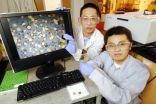(Press-News.org) La Jolla, CA, October 28, 2010 – For Immediate Release – A group of researchers at The Scripps Research Institute and the Scripps Translational Science Institute has published a paper that reviews new strategies for identifying collections of rare genetic variations that reveal whether people are predisposed to developing common conditions like diabetes and cancer.
In our modern genetic age, the entire DNA sequences, or "genomes," of humans and thousands of other animals, plants, and microbial life forms have been completely decoded and are publicly available to scientists worldwide. One of the hopes now that this data is available is that scientists will be able to find genetic markers of diseases—particular bits of DNA that would identify someone as being at risk for developing a particular disease.
Knowing that a person has such a genetic predisposition could be a powerful tool for preventative medicine because, depending on the disease in question, there may be specific drugs or behavioral modifications like diet or exercise that doctors could prescribe to their patients early on to prevent or significantly lessen the impact of those diseases later in life.
Finding these genetic markers has proven to be difficult, however, and despite the fact that the human genome has been available to researchers for years, scientists have only discovered the underlying genetic determinants for about five to ten percent of the heritable component of most common human diseases.
"There's a long way to go," says Nicholas J. Schork, Ph.D., who is a professor at Scripps Research and director of biostatistics and bioinformatics at the Scripps Translational Science Institute. In the November 2010 issue of Nature Reviews Genetics, Schork and his colleagues outline new statistical strategies that may help to close the gap in the coming years.
Part of the problem, Schork says, is that most studies up to now have focused on identifying common genetic markers of diseases—those definitive DNA signatures that are unmistakably linked to diseases because they are shared by large groups of people who have those diseases.
Such investigations, typically referred to as "genome-wide association studies," use statistical algorithms to sift through DNA samples and pull out whatever common variations exist that exhibit signs of association with a condition. While powerful, these statistical methods may not shed light on many diseases, says Schork, because not all diseases have such definitive DNA signatures. Many of the most common diseases are more complex. They are associated with multiple genes and multiple environmental factors.
According to Schork, the key to identifying the genetic components of these complex diseases is not to focus on finding single common genetic signatures that people share—but rather to identify whole collections of rare genetic signatures, any one of which may indicate a predisposition toward a disease.
The situation is analogous to asking how someone from outside New York City could get to Times Square in Manhattan. There is no single answer to that question because there are any number of approaches and modes of transportation—from New Jersey, from Brooklyn, from Wall Street, or from the Bronx, and via plane, bus, train, taxi, ferry, bridge, tunnel, subway, or sidewalk.
Regardless of where they start or how they get there, it is possible for many people to wind up at exactly the same spot, though, and Schork says the same is true for many human diseases. There may not be one single genetic marker for many diseases, but multiple markers involving any number of genes, even among people who share the same disease.
Finding these rare signatures requires a great deal more scientific sleuthing, says Schork, and in their Nature Review Genetics article Schork and his colleagues suggest a new approach to discover all the possible combinations.
This approach will require collaborations between mathematicians and computer scientists, who have the skills needed to tease out these elusive genetic markers, and biologists who can shed light on what those genes do.
"Mathematics, statistics, and fancy computers alone won't do it," Schork says. "A much more integrative approach has to occur in order to make sense of DNA sequence data."
INFORMATION:
The article, "Statistical analysis strategies for association studies involving rare variants," is authored by Vikas Bansal, Ondrej Libiger, Ali Torkamani, and Nicholas J. Schork. It appears in the November issue of Nature Reviews Genetics. See http://www.nature.com/nrg/journal/v11/n11/abs/nrg2867.html
This work was funded by grants and support from the National Institutes of Health, the Price Foundation, Scripps Genomic Medicine, and Charles University.
About The Scripps Research Institute
The Scripps Research Institute is one of the world's largest independent, non-profit biomedical research organizations, at the forefront of basic biomedical science that seeks to comprehend the most fundamental processes of life. Scripps Research is internationally recognized for its discoveries in immunology, molecular and cellular biology, chemistry, neurosciences, autoimmune, cardiovascular, and infectious diseases, and synthetic vaccine development. An institution that evolved from the Scripps Metabolic Clinic founded by philanthropist Ellen Browning Scripps in 1924, Scripps Research currently employs approximately 3,000 scientists, postdoctoral fellows, scientific and other technicians, doctoral degree graduate students, and administrative and technical support personnel. Headquartered in La Jolla, California, the institute also includes Scripps Florida, whose researchers focus on basic biomedical science, drug discovery, and technology development. Scripps Florida is located in Jupiter, Florida. For more information, see www.scripps.edu
Scientists describe new approach for identifying genetic markers for common diseases
2010-10-29
ELSE PRESS RELEASES FROM THIS DATE:
Rictor protein offers scientists a new molecular target for cancer therapies
2010-10-29
BOSTON – The discovery that a protein called Rictor plays a key role in destroying a close cousin of the AKT oncogene could provide scientists with a new molecular target for treating certain cancers, including breast cancer. Described in the September 2010 issue of the journal Molecular Cell, the study was led by scientists at Beth Israel Deaconess Medical Center (BIDMC).
The oncogenic cousin, known as SGK1, resembles the widely known AKT oncogene in structure, according to the study's senior author Wenyi Wei, PhD, of the Department of Pathology at BIDMC and Assistant ...
Insulin-creating cell research may lead to better diabetes treatment
2010-10-29
LIVERMORE, Calif. – Beta cells, which make insulin in the human body, do not replicate after the age of 30, indicating that clinicians may be closer to better treating diabetes.
Type 1 diabetes is caused by a loss of beta cells by auto-immunity while type 2 is due to a relative insufficiency of beta cells. Whether beta cells replicate after birth has remained an open issue, and is critically important for designing therapies for diabetes.
By using radioactive carbon-14 produced by above-ground nuclear testing in the 1950s and '60s, researchers have determined that the ...
Organic solvent system may improve catalyst recycling and create new nanomedicine uses
2010-10-29
Noble metals such as platinum and palladium are becoming increasingly important because of growth in environmentally friendly applications such as fuel cells and pollution control catalysts. But the world has limited quantities of these materials, meaning manufacturers will have to rely on efficient recycling processes to help meet the demand.
Existing recycling processes use a combination of two inorganic acids known as "aqua regia" to dissolve noble metals, a class of materials that includes platinum, palladium, gold and silver. But because the metals are often dissolved ...
A recent IRCM breakthrough impacts cancer research
2010-10-29
Montreal, October 28, 2010 – A team of scientists at the Institut de recherches cliniques de Montréal (IRCM) led by Dr. Jean-François Côté, Director of the Cytoskeletal Organization and Cell Migration research unit, identified a novel molecular mechanism in the control of cell motility. Their findings were published online today in Current Biology, a journal from the Cell Press group. This scientific breakthrough could eventually lead to the development of new cancer-treating drugs that could block the spread of tumours (metastasis).
"As many as 90% of cancer patient ...
Spacecraft will enable scientists to study space environment around moon, Earth
2010-10-29
Two spacecraft are now beginning to study the moon's environment as part of NASA's ARTEMIS mission, whose principal investigator is Vassilis Angelopoulos, a UCLA professor of Earth and space sciences.
One of these satellites has been in the lunar environment since Aug. 25, and the second arrived Oct. 22, marking the start of the ARTEMIS mission to gather new scientific data in the sun-Earth-moon environment.
ARTEMIS is an acronym for Acceleration, Reconnection, Turbulence and Electrodynamics of the Moon's Interaction with the Sun.
For roughly six months, the ...
Immigrant Latinos in rural Illinois have unique child care needs
2010-10-29
URBANA – Finding good child care and being able to engage easily in important interactions with your child care provider are critical to any mother's ability to work outside the home.
"Suppose you're living in the rural Midwest and you don't speak English very well. Can you imagine leaving your child with a child care provider if you couldn't communicate well with that person?" said Angela Wiley, a University of Illinois associate professor of applied family studies.
"The immigrant moms we interviewed for this study faced just this dilemma," she said.
Immigrant Latino ...
Newly discovered regulatory mechanism essential for embryo development and may contribute to cancer
2010-10-29
Researchers from Mount Sinai School of Medicine have identified a mechanism controlling the function of a protein that binds to DNA during embryonic development and may function to prevent abnormal tumor growth. When the protein, TCF3, is modified by a small molecule called a phosphate, it no longer binds DNA, changing the way the protein signals during development. This discovery identifies a new diagnostic marker (phosphorylated TCF3) that may be associated with cancer and could represent a potential drug target. The results are published in the current issue of Developmental ...
UM researchers are studying child-mother interactions to design robots with social skills
2010-10-29
CORAL GABLES, FL (October 28, 2010)—To help unravel the mysteries of human cognitive development and reach new the frontiers in robotics, University of Miami (UM) developmental psychologists and computer scientists from the University of California in San Diego (UC San Diego) are studying infant-mother interactions and working to implement their findings in a baby robot capable of learning social skills.
The first phase of the project was studying face-to-face interactions between mother and child, to learn how predictable early communication is, and to understand what ...
Wild Scottish sheep could help explain differences in immunity
2010-10-29
Strong immunity may play a key role in determining long life, but may do so at the expense of reduced fertility, a Princeton University study has concluded.
An 11-year study of a population of wild sheep located on a remote island off the coast of Scotland that gauged the animals' susceptibility to infection may give new insight into why some people get sicker than others when exposed to the same illness.
The answer to this medical puzzle may lie in deep-rooted differences in how animals survive and reproduce in the wild, according to the study, which was led by Princeton ...
Phosphorus identified as the missing link in evolution of animals
2010-10-29
A University of Alberta geomicrobiologist and his PhD student are part of a research team that has identified phosphorus as the mystery ingredient that pushed oxygen levels in the oceans high enough to establish the first animals on Earth 750 million years ago.
By examining ancient-ocean sediments, Kurt Konhauser, student Stefan Lalonde and other colleagues discovered that as the last glacier to encircle Earth receded, leaving behind glacial debris containing phosphorus that washed into the oceans. Phosphorus is an essential nutrient that promoted the growth of cyanobacteria, ...

